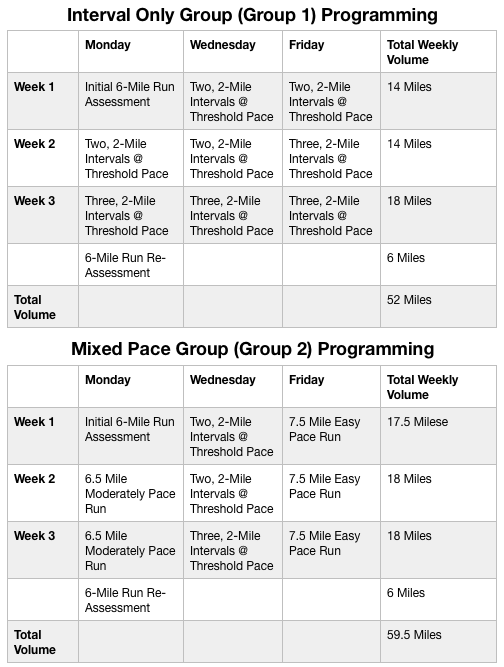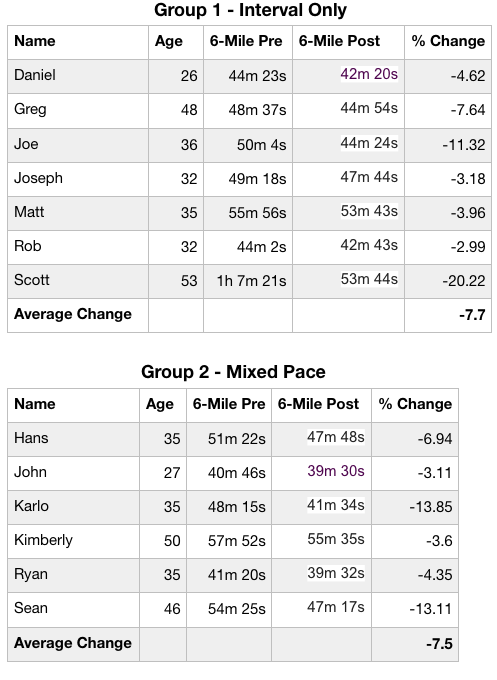By Rob Shaul
BLUF
This 4-week Mini-Study compared the programming effectiveness of (1) threshold-only running and (2) multi-paced running (threshold, moderate, easy) to improve 6-mile running times. The results found both programming approaches improved average 6-mile run times 7-8%, with no significant difference between the programming approaches.
BACKGROUND & STUDY DESIGN
(1) Will Group 2’s longer distances and different pacing result in an increase in assessment performance?
(2) If so, will this approach outperform interval-only work (Group 1) in improving assessment performance?
Two 3.5-week cycles were designed to test the study progressions above, and MTI advertised for Lab Rats via our weekly newsletter, Beta, which has 35,000+ weekly subscribers.
Lab Rat volunteers were randomly assigned into groups: Group 1 (Interval Only) and Group 2 (Mixed Pace).
The Study was completed in the January-February 2020 time frame, and the study subjects self-reported their pre and post cycle assessment results.
Each Group completed a total of 10 training sessions. These included the two pre and post-study 6-Mile run assessments.
The Mini-Study was designed to complement the athletes’ regular training. We asked participants to avoid all other running during the study duration.
Both groups began the study with a 6-mile run assessment, which was used to prescribe pacing for follow on running efforts using the MTI Running Interval Calculator.
Interval Only Group – Group 1
This group ran only threshold-paced, 2-mile intervals, based on their 6-mile run assessment time. In all, the group completed four training sessions of two, 2-mile threshold intervals, and four training sessions of three, 2-mile threshold intervals. The prescribed threshold pace for each 2-mile interval was approximately 20% faster than the individual athlete’s average per-mile 6-mile assessment pace.
Mixed Pace Group – Group 2
This group completed three, threshold-paced, 2-mile interval sessions, two, 6.5-mile moderate-paced sessions (10-20% slower than their 6-mile assessment pace), and three 7.5 miles easy-paced sessions (20-25% slower than their 6-mile assessment pace).
Below is the programming outline for both groups:
RESULTS & DISCUSSION
A total of 13 individuals with an average age of 37.7 completed the study.
Group 1 (interval only) athletes say an average 7.7% decrease in their 6-mile run time over the course of the study.
Group 2 (mixed pace) saw an average 7.5 decrease in their 6-mile run time over the course of the study.
Below are the individual and overall results.
Study design elements that could have impacted these results could include it’s a relatively short duration (3.5 weeks), and how other training may have impacted running performance.
By design, this study didn’t dictate the athlete’s full training regimen during the study period as we wanted to test the ability to study a focused fitness attribute change without dictating complete programming. This was done to encourage lab rat participation and decrease attrition.
Going in, we had two research questions:
(1) Will Group 2’s longer distances and different pacing result in an increase in assessment performance?
Yes. Group two’s average improvement was 7.5%.
(2) If so, will this approach outperform interval-only work (Group 1) in improving assessment performance?
Yes and no. Group 2 did not out-perform Group 1’s average improvement but did nearly match it.
Overall, I was somewhat surprised by these results as I expected the interval only group (Group 1) to clearly out-perform the mixed pace group. This was not the result.
NEXT STEPS
While neither programming approach was the clear winner, knowing that mixed pace programming performs as well as interval-only programming does give us another programming option for running improvement.
Next steps would be to replicate this study for both rucking and swimming.
Questions, Comments, Feedback? Email rob@mtntactical.com
You Might Also Like Geek Cycle: Leg Blasters Match Front Squat in Building Lower Body Strength



